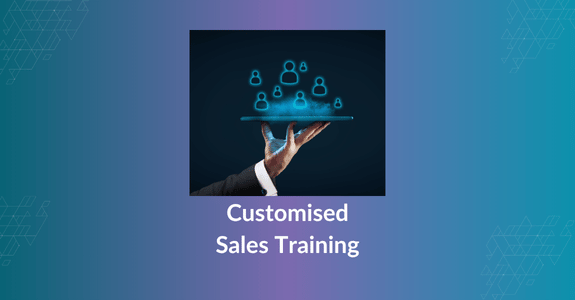Context Over Content: Customised Sales Training
by Mentor Group

Introduction
Off‑the‑shelf content rarely changes behaviour. Sellers need examples, language and scenarios that look and feel like their world. Customising training doesn’t mean starting from scratch; it means mapping proven patterns to your customers, stages, risks and tooling.
For the broader blueprint on what good sales training includes, see the pillar: What Should Good Sales Training Include?
Why Customise? (Outcomes, Not Aesthetics)
- Relevance—fewer translation steps between training and tomorrow’s calls.
- Confidence—sellers practise using the language stakeholders expect.
- Consistency—teams in different regions follow the same standards while using local examples.
Customisation is about application, not shiny slides—so focus on what sellers do differently afterwards.
What to Tailor (The Big Five)
- Customer language—use the buyer’s terms for problems, outcomes and risks.
- Sales stages and artefacts—align to your CRM stages, qualification language and required documents.
- Sector realities—regulatory constraints, procurement paths, risk appetite and typical stakeholders.
- Personas & stakeholders—actual decision makers and influencers by segment.
- Tech stack—how training, practice and prompts appear inside CRM and collaboration tools.
Customising for Your Routes to Market (GTM)
Different motions demand different emphasis:
- Enterprise—multithreading, executive narratives, proof packs and risk management.
- Mid‑market—velocity, objection patterns and pragmatic commercial options.
- Channel/partner—shared value story, role clarity and enablement assets partners can use.
- PLG/inside—product‑led discovery, usage signals and expansion narratives.
Customising for Sector
- Financial Services—compliance, risk committees, vendor onboarding and data residency.
- Healthcare/Life Sciences—patient safety, clinical validation, procurement frameworks.
- Technology—integration depth, security posture and ROI in fast cycles.
Keep examples short and specific—screenshots, anonymised excerpts and buyer quotes beat generic case studies.
Customising for Your Tech Stack
Training should live where work lives. Embed nudges and examples in the tools your team already uses:
- CRM—stage‑specific prompts and checklists; links to best‑practice artefacts.
- Collaboration—Teams/Slack messages to launch practice, share exemplars and celebrate adoption.
- Practice tech—AI role‑plays and simulations that mirror your sectors and personas.
Map integrations first; platforms should adapt to your flow, not the other way round.
How to Build Customised Content Fast (Without Heavy Lift)
- One‑page diagnostic—name the two behaviours to change and the outcomes they affect.
- Template + localise—start with a proven pattern, then swap in your language, artefacts and examples.
- Micro‑modules—10–20 minute lessons, each tied to a single scenario and practice task.
- Practice first—create digital role‑plays before long decks; repetition matters more than slides.
- Manager prompts—give coaches ready‑to‑use questions and quick activities in the workflow.
Governance, Accessibility and Change Control
- Privacy—use redacted/synthetic data in examples and practice clips.
- Accessibility—captions, transcripts and readable colour contrast.
- Change control—version content and keep a short change log so regions stay aligned.
Pilot Plan (30–45 Days)
- Week 0–1: Define use‑case, behaviours, and success measures.
- Week 1–2: Localise two micro‑modules + matching practice scenarios.
- Week 2–4: Launch to a small cohort; run manager‑led embedding.
- Week 4–6: Gather examples, adjust language, publish what to scale/retire.
Common Pitfalls (and Fixes)
- Over‑customising → lock core patterns; localise language and artefacts only.
- Portal sprawl → deliver inside CRM/collaboration whenever possible.
- Too many reviewers → nominate one content owner per region.
- No practice → prioritise role‑plays/simulations over long decks.
Bottom Line
Q1. Why customise sales training?
A1. Customisation reduces the gap between learning and doing—so sellers use buyer language, follow your stages and apply skills in real opportunities faster.
Q2. What should we tailor first?
A2. Customer language, CRM stages/artefacts, sector‑specific risks, real personas and how content/practice appear inside your tools.
Q3. How do we customise quickly?
A3. Start with a proven template, localise examples and artefacts, and ship micro‑modules with matching practice scenarios for immediate application.
Q4. How does customisation differ by sector?
A4. Emphasise compliance and risk in FS/Healthcare; highlight integration, ROI and speed in Technology—always using buyer‑specific evidence.
Q5. How should training integrate with our tech stack?
A5. Embed prompts and examples in CRM and collaboration tools, and mirror your sectors/personas in practice tech so work stays in flow.
Q6. What’s a sensible pilot?
A6. 30–45 days with two micro‑modules and matching practice; run manager‑led embedding and decide what to scale based on examples and outcomes.
Q7. What governance should we consider?
A7. Redact sensitive data, ensure accessibility, and version content with a short change log so regions stay aligned.
